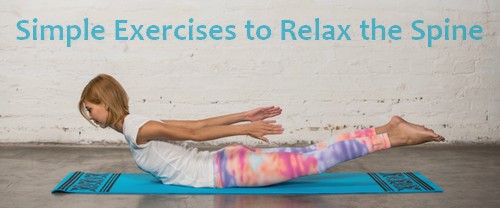Well, you certainly need to be careful when applying any recommendations that were given to you by someone who is not your doctor and/or who doesn’t know you personally to assess your issues adequately. That’s just some wimp warning. 🙂
So, how do you relax your spine and should you?
The relaxation is a procedure of the two-fold benefit: it gives some pleasant sensations and improves the health of your back. If you develop a habit to regularly remove any tension your back accumulates during the day, you will not only prolong its healthy life but additionally prevent or even remove some associated diseases. For instance, if such a habit obtained at the age of 20-25, there is a good chance that a person won’t suffer from backache later on, even being engaged in a sedentary office work. But regular back relaxation is beneficial for anyone at any age.
The easy exercises to relax the spine and back muscles

1. The initial position: place your feet at the shoulders’ width, your palms are on the waist. With inhale rise the right shoulder, and then lower it with exhale. Do the same with the left shoulder. You can repeat it several times (do it according to what you feel).
2. The same position: inhale, exhale, and lower your head and press the chin against your chest. Pull the back up and forward, trying to round it (while leaning forward a little), which means you need to work with the upper back, trying to stretch it.
3. Lean forward as far as it is comfortable for you, ultimately trying to reach the floor or your feet. Do it on exhale. You may want to remain in the final position for a while, then come up with inhale.
4. The starting position is lying on the stomach. Place the arms along the torso, and on inhalation rise the shoulders, chest and the upper back slowly above the floor. Keep the lower abdomen on the floor, and remain in this pose for 2-4 seconds, then return to the starting position on exhalation.
5. Keeping the same pose, rise the legs only, then lower them.
6. This one is a combination of the previous two: while on the stomach, grab your feet, arch backwards simultaneously rising your legs with the help of the arms. The final pose looks like a ring or circle; only the stomach remains on the floor. This is similar to Dhanurasana pose from yoga. Be careful while trying it, especially if you are not accustomed to regular physical activity and/or have some serious spine issues ( in that case it may be better to consult with your doctor before you even try this pose).
7. Now lie on your back, bent the knees, bringing the feet closer to the buttocks. Now arch your back gently upward; shoulders and neck remain on the floor.
8. This one is the extension of the previous exercise: now you need to arch your back upward, and your body will rest on the feet and palms – this is Urdhva Dhanurasana or Chakrasana pose from yoga. Do it with even more care than the previous one.
How to do it: bring your feet to the buttocks; place the hands next to the ears on the floor. Inhale, and on exhale straighten your legs and arms, arching the back upward. Hold the pose for 2-4 seconds, breathing normally, then return to the floor on exhalation.
Some tips to follow
Actually these tips are more like rules or directions, since they are very important so don’t take them too lightly.
- Never ever exercise on a full stomach.
- Do each exercise 5-10 times, but track your body’s response to avoid overtraining.
- Do everything slowly without sharp movements; hold the final pose for few seconds.
- Do not try to exercise through pain and force – it should be through the discipline and concentration.
- Relax for 30 seconds after each cycle of 8 repetitions.
- Begin and conclude the whole complex by the following pose: lie on your back, pull the feet to the buttocks, knees bent, then place the thighs on your belly or chest, embrace the knees with your arms. This position will let your spine to rest and relax. Try to ‘catch’ the pleasant feeling the pose gives, and keep it during the training session (when the pose is done in the beginning). At the end do this exercise longer, than in the beginning.
How the muscle relaxation benefits my spine and back?
- It Increases the intervertebral space
- The Trapped nerve roots are released
- Your whole spine and its surrounding muscles receive better blood flow, which brings all those nutrients to them that are essential to their health, and helps to remove toxins.
Is there anything else to help me relax better?
Yup, here they are:
- Healthy activities, like hiking
- Relaxation under the appropriate musical composition
- Positive affirmations (it’s really like self-hypnosis: you ‘tune’ your mind to positive waves, ‘resetting’ the negative ones at the same time).
